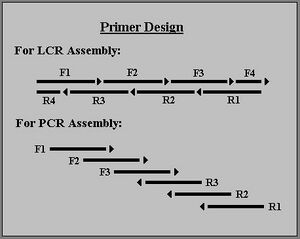DNA Synthesis from Oligos
| back to protocols | ||
Overview
Despite claims by Synthesis companies for cheap gene/DNA synthesis, there are times when manual synthesis is necessary. This can be done relatively easily by ordering the necessary oligos of both strands, and a bit of thermo-cycling.
This synthesis can be accomplished using two methods: Ligase Chain Reaction (LCR) or Polymerase Chain Reaction (PCR). While both protocols are similar, they have some distinct differences which will be described here.
LCR Synthesis Procedure
1. Design oligos for your gene, of both strands (see the notes on primer design below).
2. Dilute the oligos to 100uM.
3. Kinase the oligos.
4. Thermo-cycle:
- For Thermostable Taq Ligase: do as many cycles as necessary (10-30).
- 95°C (denature)
- 45-55°C (anneal)
- 65°C (ligate)
- For T4 ligase: do 5-10 cycles, add more ligase and ATP, and do 5-10 more.
- 95°C (denature, 15 sec)
- 45-55°C (anneal, 30 sec)
- 20°C (ligate)
5. Clean up PCR product to remove enzyme and primers.
6. Rescue PCR with end primers, using ligation cycling product as template.
7. Gel extract.
8. Clone.
PCR Synthesis Procedure
1. Design oligos for your gene, of both strands(see the notes on primer design below).
2. Dilute the oligos to 100uM.
3. Mix together the following:
- 1μL of each primer
- 1µL dNTPs (10mM each)
- 1µL Taq Polymerase (1000 units/mL)
- 5µL 10X Buffer
- ?μL Sterile DI water to make a final volume of 50μL
4. Thermo-cycle the mix 30X:
- 95°C (denature, 20 sec)
- 45-55°C (anneal, 20 sec)
- 72°C (extend, 40 sec)
5. Take 2μL of this Synthesis product set up PCR mix as before but with only the 5' end-primers (forward and reverse).
6. Thermo-cycle 30X:
- 95°C (denature, 20 sec)
- 72°C (anneal and extend, 60 sec)
- Because you are using the entire oligo as a primer, the Tm will be unusually high. Because of this, annealing and extention can be done in the same step.
- Because you are using the entire oligo as a primer, the Tm will be unusually high. Because of this, annealing and extention can be done in the same step.
6. Clean up PCR product to remove enzyme and primers.
7. Gel extract.
8. Clone.
Notes

- Primer design for the two types of synthesis are different. For a rough determination of primers see the figure to the right. Arrows point in the 5' to 3' direction.
- Some online oligonucleotide design tools are Gene2Oligo and TmPrime
- Make primers fixed 30-40mers with 15-20mer overlaps; or use the software by Rouillard et al. referenced below.
- This works well for relatively for short fragments (300-500 bp). For longer sequences, use PCR Overlap Extension of the fragments.
- If you want to include restriction sites at the ends of your DNA you may need to add a little bit of "junk" sequence flanking the restriction site. Check this link to find out about your specific enzyme. Some examples are:
- BamHI needs two bases
- EcoRI needs one base
- HindIII needs more than three
References
Rouillard et al. Gene2Olig: oligonucleotide design for in vitro gene synthesis. [1]